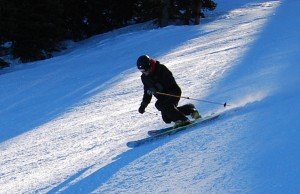What are some typical skiing injuries?
Skiing injuries are the absolute pits and can ruin an otherwise perfect time away. Not surprisingly the knees are the number one area that suffer during skiing holidays. Shoulder dislocation is another common complaint, as is concussion. But one injury that many people don’t anticipate is skier’s thumb.
Obviously, good equipment and proper instruction are vital to guard against possible mishaps, but what other measures should you take? And if you are unlucky enough to get injured, what sort of treatment would suit you best?

Skiing injuries
Getting into shape for skiing
It is important to remember that skiing is a dynamic activity, it involves lots of powerful movements of big muscle groups, but also involves fine motor skills.
Because the knees are so vulnerable to the recreational skier, it is important to develop the muscles that support the knees. Traditional static weight training might help to develop some strength and toning, but you also need to include some dynamic exercises into your pre-skiing routine.
One of the best exercises you can do is the good old fashion squat. Simply keep your back straight and your neutral spine, and your chest and shoulders up. Keep looking straight ahead at a spot on the wall. As you squat down to no more than 90 degrees, focus on keeping your knees in line with your feet.
If you are a little bit fitter, you could consider doing jump squats or incorporating some kettlebell squats into your routine.
Other exercises that are dynamic and helpful include skipping or even hopping. All these exercises are best performed on a sprung floor, so if you have access to an aerobic room in your local gym, that would be the ideal surface to practice these movements.
As well as improving strength, you need to consider training your sense of balance as well. There are two good options for improving balance, the wobble board or the Bosu balance trainer. Many people only start using these bits of equipment during rehabilitation, but they are excellent for pre-habilitation too.
Dealing with skiing injuries
Firstly a word of warning, if you have previously injured yourself skiing, make sure you get a proper physical screening before going on your next trip. Opening up old injuries can be a recipe for disaster.
The key is to maintain flexibility, improve your balance and have good underlying muscle tone. If you are unlucky enough to get injured though, there are some immediate dos and don’ts you should adhere to.
Obviously, if the injury is severe, you should seek immediate medical attention. For all minor injuries, it is best to follow the ‘PRICE’ therapy method to deal with the injury. Here is a link to a clear explanation of what ‘PRICE’ therapy involves.
The biggest no-no is drinking alcohol. If you injure yourself early in your trip it might be tempting to drown your sorrows with a tipple or two. This will massively slow down your recovery rate, and can also lead to further mishaps down the line.
On your return to the UK seek immediate help from qualified practitioners. Be patient, and stick rigorously to any programme of rehab.
We hope this information was useful for you. If you have any questions about it or about our treatments, please contact us. We are in Mill Hill Broadway and Islington. We are always happy to help.



